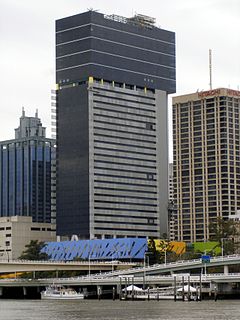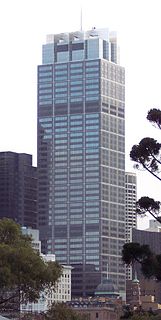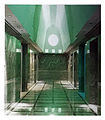Melbourne Museum is a natural and cultural history museum located in the Carlton Gardens in Melbourne, Australia.

Helmut Jahn is a Chicago-based German-American architect, known for designs such as the Sony Center on the Potsdamer Platz in Berlin, Germany; the Messeturm in Frankfurt, Germany; the One Liberty Place in Philadelphia, Pennsylvania ; and the Suvarnabhumi Airport, an international airport in Bangkok, Thailand. Recent projects include a residential tower in New York City, 50 West St in 2016 and the Thyssenkrup Test Tower in Rottweil, Germany in 2017.

Southbank is an inner urban neighbourhood of Melbourne, Victoria, Australia, 1 km south of the Melbourne central business district. Its local government area are the cities of Melbourne and Port Phillip. At the 2016 Census, Southbank had a population of 18,709. Its southernmost area is considered part of the central business district of the city. Southbank is bordered to the north by the Yarra River, and to the east by St Kilda Road. Southbank's southern and western borders are bounded by Dorcas Street, Kings Way, the West Gate Freeway and Montague Street.
The year 1996 in architecture involved some significant architectural events and new buildings.
The year 1991 in architecture involved some significant architectural events and new buildings.
The year 2007 in architecture involved some significant architectural events and new buildings.

The Melbourne Convention and Exhibition Centre is the name given to two adjacent buildings next to the Yarra River in South Wharf, an inner-city suburb of Melbourne, Victoria, Australia. The venues are owned and operated by the Melbourne Convention and Exhibition Trust.

Spring Street is a major street in the central business district of Melbourne, Australia. It runs roughly north-south and is the easternmost street in the original 1837 Hoddle Grid.
101 Collins Street is a 260-metre (853 ft) skyscraper located in Collins Street, Melbourne central business district, Victoria, Australia. The 57-storey building was completed in March 1991 under the design by Denton Corker Marshall. Towards the end of project, with a change of developer, the foyer space was designed by Johnson Burgee.

Brisbane Square is a high-rise building in Brisbane, Queensland, Australia. The building has 38 floors and rises to 151 metres. The building's main use is for office space, the lower floors leased to retailers, with a 350-space car park below the building. Significant tenants include the Brisbane City Council and Suncorp.

The Grollo Tower was a proposed skyscraper development in the Docklands precinct of Melbourne, Australia. The developer was Grocon, a construction company owned by the Grollo family.

Aurora Place is the common name of Renzo Piano's award-winning office tower and residential block on Macquarie Street in Sydney, Australia. Its official name is the RBS Tower building. The 41-storey structure is 218 metres (718ft) high to the top of the spire and 188 metres to the roof.

The Governor Phillip Tower, the Governor Macquarie Tower and the Museum of Sydney are the main elements of one of the largest developments in the central business district of Sydney, New South Wales, Australia. Completed in 1994, the property development complex occupies an elevated site in the north-east area of the central business district. The complex incorporates the site of the first Government House, one of Australia’s earliest and most significant sites of European heritage. The address is 1 Farrer Place, Sydney. Designed by architects Denton Corker Marshall and built by Australia's largest privately owned construction company Grocon, at the time of its completion it was regarded as achieving new standards for Sydney commercial architecture in terms of finish quality and design.
The Robin Boyd Award for Residential Architecture is an Australian architectural prize presented by the Australian Institute of Architects since 1981.

Manchester Civil Justice Centre is a governmental building in Manchester, England. Completed in 2007, it houses Manchester's county court and the Manchester District Registry of the High Court, the city's family proceedings court, the district probate registry, and the regional and area offices of the Court Service.

The Adelphi Hotel was originally constructed in 1938 is located in one of Melbourne’s most famous lane ways at 187 Flinders Lane.

Yvonne von Hartel AM is one of the founding members of the award-winning Melbourne-based architectural and urban planning firm peckvonhartel, which was established in 1980 and since has expanded its offices to Sydney, Canberra and Brisbane. Von Hartel was the first woman to graduate with an honours degree in architecture from the University of Melbourne and is a Life Fellow of the Australian Institute of Architects (LFAIA).

The Argus Centre is a postmodernist highrise office building situated on the corner of La Trobe Street and Elizabeth Street, Melbourne. It was designed by architect Nonda Katsalidis whilst he was a director of AXIA Pty Ltd for client Ryssal Three. The project team consisted of Nonda Katsalidis, Gerard Van Beer, Geoff Cosier, Ric Wood, Philip O’Dwyer, Shmuel Dolev, Leon Moulton and John Iappazutto. The building was constructed between 1991 and 1993 with a contract value of AUS $64 million. The current value of the building is $173.9 million.

The Central Library is the main library of the University of Indonesia in Depok, Indonesia. Selected in an open design competition, the design concept was conceived by Denton Corker Marshall. The new library conceptually bridges the ancient knowledge and the contemporary knowledge in a form inspired by the ancient stone steles and light-play.




















